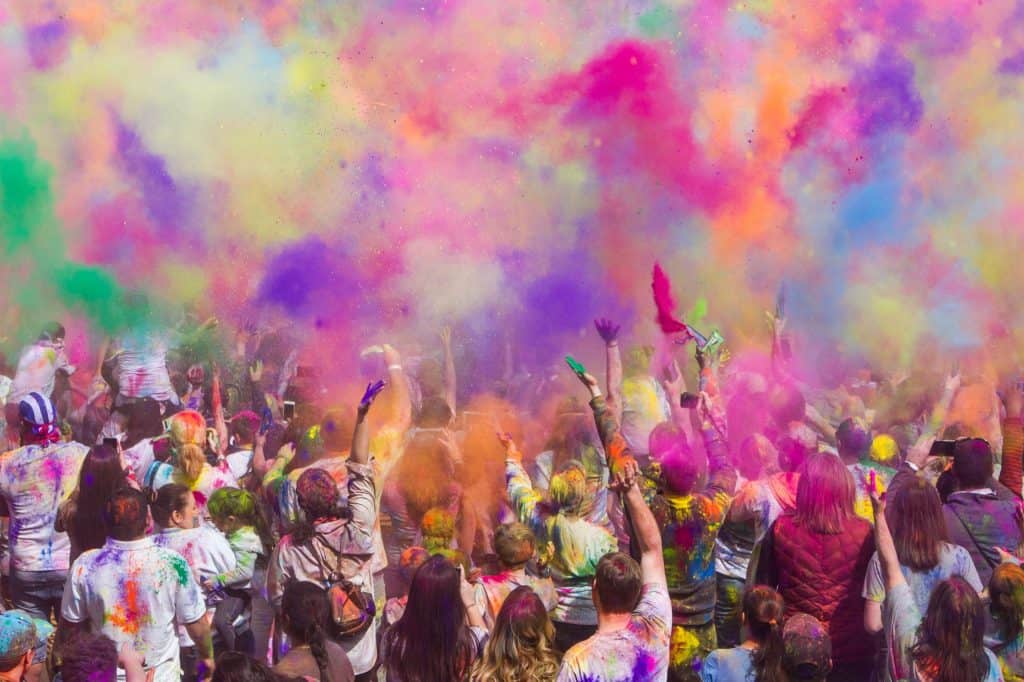by Lianne Kolirin
Holi is an annual festival in which Hindus celebrates the end of winter by dousing each other in colourful powders and waters
What is Holi?
This ancient festival of colours originated in India but is now commemorated across the sub-continent and in
Hindu and
Sikh communities around the world.
Perhaps the most photogenic of all religious festivals and seen as the second most important event in the Hindu calendar, Holi sees young and old take to the streets to douse each other in multi-coloured powders and water to mark the arrival of spring — regarded by Hindus as “the king of all seasons”.
Holi, sometimes known as the “festival of love”, essentially celebrates new life, fertility and good overcoming evil on the full moon in the month of Phalguna.
Lasting for a day and a night, it is celebrated with the name Holika Dahan or Choti Holi on the first evening of the festival and the next day is called Holi — although there are regional variations.
The first day is generally marked by people gathering around a bonfire to celebrate good triumphing over evil. The vibrant colour-pelting takes place the next day.
Where does Holi come from?
Some say the bonfire tradition stems from a legend about two siblings, Holika and her brother Hiranyakashipu. A demon king, Hiranyakashipu believed he was a god and that his subjects should worship him — or face severe punishment.
So when his son Prahlad continued to worship Vishnu, Hiranyakashipu planned his son’s murder with his demon sister. But the murderous scheme backfired and it was Holika rather than her nephew who was killed in a blaze of fire. This is the reason that the festival, named after Holika, begins with a bonfire.
The practice of throwing colourful powder stems from another legend surrounding the Hindu god Krishna. Krishna played Holi with Gopas and Gopis in Vrindavan during his childhood.
Another interpretation is that he is said to have complained to his mother about his blue skin, saying he wanted to be fairer like his beloved Radha. So his mother Yashoda suggested he paint Radha’s face. After following his mother’s advice, the pair are said to have fallen in love and married.
How is Holi celebrated in the UK?
Rajnish Kashyap, director of the Hindu Council UK, said: “Hindus settled in the UK do not miss out the excitement of Holi celebrations and enjoy it to the hilt. Zeal for the festival is particularly marked in this country as Indians constitute the second-largest ethnic minority. Celebrating festivals helps them to feel close to their families and cultural roots.”
Mr Kashyap said festivities in the UK tended to take place in temples or in parks where there were large Hindu communities.
He added: “Holi parades are also carried and in the evening; people visit their friends and relatives to exchange greetings and sweets. They hug each other and apply the
tilak [holy mark] as they meet Holi in a traditional manner.
Lianne Kolirin is a freelance journalist
Useful links
Holi in Barsana
Festival of colours, a BBC Bitesize guide to Holi
The Hindu festival of Holi, a blog from the British Museum
Encyclopaedia Britannica’s definition of Holi
Useful contacts
Rajnish Kashyap, general secretary/director Hindu Council UK (HCUK),
[email protected]
Hindu Council UK
National Council of Hindu Temples,
[email protected]
